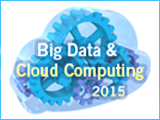IMDEA Networks

Event Category: In-house Presentation
Demo: Fronthaul and Backhaul traffic over 5G-Crosshaul data plane
This integrated demo will interconnect different transport technologies carrying backhaul traffic, fronthaul traffic and both in one network, which demonstrates the 5G-Crosshaul data plane technologies developed in the project.
Seguir leyendo arrow_right_altLoon - Google’s balloon based aerial network
The seminar will provide an introduction to the Project Loon, a network of balloons designed by Google to extend Internet connectivity to people in rural and remote areas worldwide. We will review its main technical characteristics and how it has evolved in the last couple of years. It will also review the activities carried out in cooperation with Telefónica in Latam, including technical trials in Chile and Perú, and provide an assessment of the main issues the project faces to become a sustainable commercial system. Although not likely to be covered in the seminar, we will also provide some information about other alternatives to provide connectivitivy using aerial networks, like
Seguir leyendo arrow_right_altFormalizing and Implementing Distributed Ledger Objects
Despite the hype about blockchains and distributed ledgers, no formal abstraction of these objects has been proposed. To face this issue, in this paper we provide a proper formulation of a distributed ledger object. In brief, we define a ledger object as a sequence of records, and we provide the operations and the properties that such an object should support.
Seguir leyendo arrow_right_altPrivacy in personal trajectories: problems and solutions
Collecting data generated by widespread digital transactions is an increasingly common practice. The likes of telecommunication network operators, mobile service providers, app developers and financial companies have the possibility to track the movements, preferences, activities and habits of large populations of individuals.
Seguir leyendo arrow_right_altNot All Apps Are Created Equal: Analysis of Spatiotemporal Heterogeneity in Nationwide Mobile Service Usage
We investigate how individual mobile services are consumed at a national scale, by studying data collected in a 3G/4G mobile network deployed over a major European country. Through correlation and clustering analyses, our study unveils a strong heterogeneity in the demand for different mobile services, both in time and space. In particular, we show that: (i) somehow surprisingly, almost all considered services exhibit quite different temporal usage patterns; (ii) in contrast to such temporal behavior, spatial patterns are fairly uniform across all services; (iii) when looking at usage patterns at different locations, the average traffic volume per user is dependent on the urbanization level, yet its temporal dynamics are not. Our findings do not only have sociological implications, but are also relevant to the orchestration of network resources.

Crowdsourcing Spectrum Data Decoding
Crowdsourced signal monitoring systems are gaining attention for capturing the wireless spectrum at large geographical scale. Yet, most of the current systems are still limited to simple power spectrum measurements reported by each sensor.
Seguir leyendo arrow_right_alt9th IMDEA Networks Annual International Workshop: Enabling future internet applications
IMDEA Networks Institute annually holds a by-invitation-only thematic workshop in Madrid. The workshop accompanies a meeting of our Scientific Council comprised of prominent researchers. In addition to talks by Scientific Council members, the workshop includes invited talks by external experts in the research theme of the workshop. The goal of the 2017 event is to foster discussion about future internet applications with particular focus on networking, privacy and security challenges.
Seguir leyendo arrow_right_alt5G – Standardization, current state and evolution
The seminar will cover the current status of the standardization in 3GPP of the new 5G radio interface (NR) and core network (NGC), including the steps undertaken for the acceleration process recently approved, that will allow for early implementations by the end of 2018.
Seguir leyendo arrow_right_altAccessing Resources in (city-wide) Networked Environments: Issues and alternatives
Access to a common (communication) resource has been one of the fundamental problems in the various networking technologies that have emerged over the last half a century.
Seguir leyendo arrow_right_altSéptimo Taller de Trabajo Anual de IMDEA Networks: Big Data y Cloud Computing
Los datos masivos o datos a gran escala (Big Data) y la computación en la nube (Cloud Computing) son dos paradigmas que están evolucionando codo con codo y revolucionando como vivimos y trabajamos. La cantidad de datos que se genera en el mundo aumenta cada día, y no hay indicios de que esta tendencia se vaya a detener a corto plazo (o nunca).
Seguir leyendo arrow_right_alt











Comentarios recientes